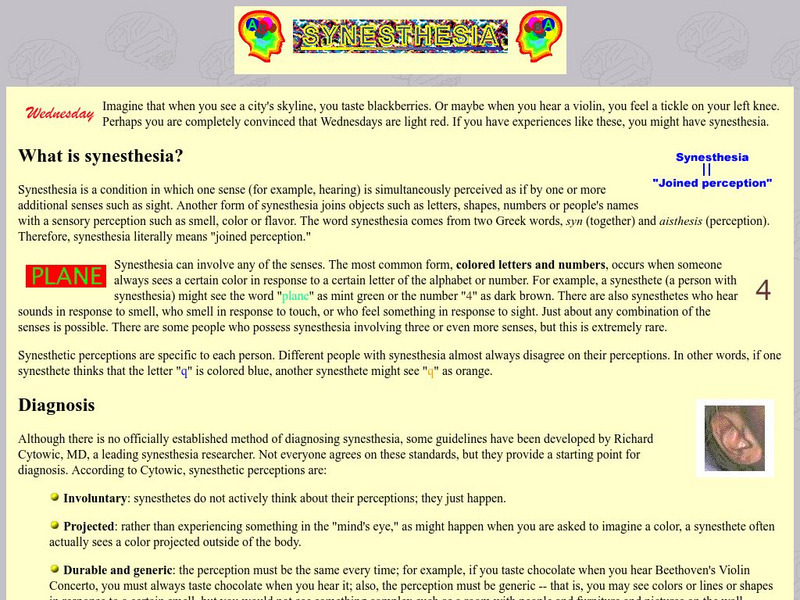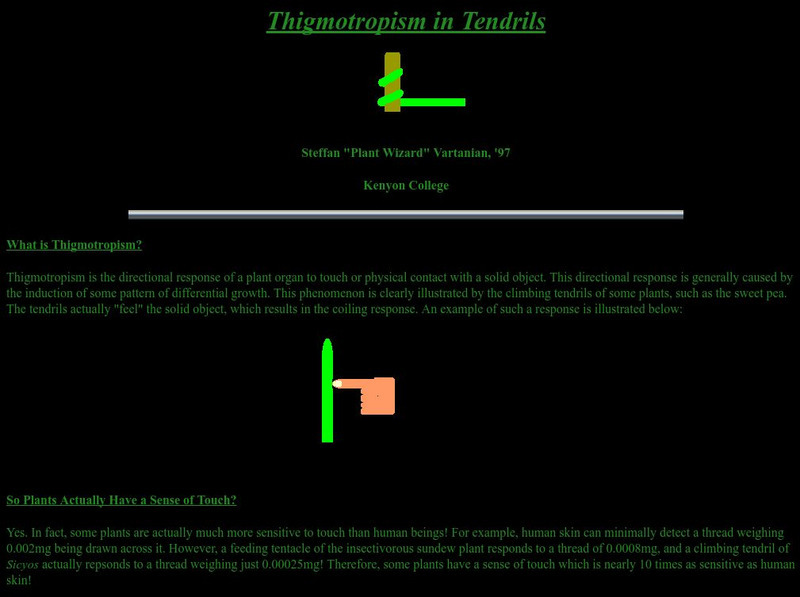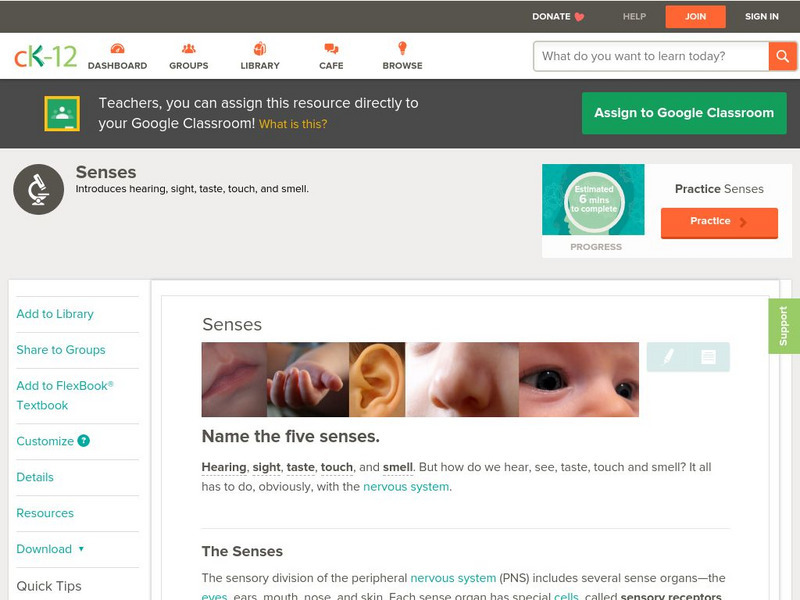University of Washington
University of Washington: The Senses Touch
Do you know what the largest sensory organ of the body is? Use this site on skin and its sense of touch to learn more.
University of Washington
University of Washington: Synesthesia
Have you ever seen something and associated it with a taste? If so, you many have Synesthesia. This condition is not widely publicized but may be present in as many as 1 out of every 200 individuals. Learn more about "joined perception"...
The Franklin Institute
The Franklin Institute Online: Coming to Our Senses
Help students make "Sense," of their senses by using them in the classroom. Site provides discovery activities students can do on themselves, in their classrooms and around campus. A scavenger hunt is also provided.
Science Education Resource Center at Carleton College
Serc: Backyard Science the Five Senses
Kindergarten young scholars will use their existing outdoor expertise to help them focus on the scientific study of their five senses in stations.
Beacon Learning Center
Beacon Learning Center: Christmas Bear and His Five Senses
Come along with Eric as he teaches Christmas Bear how to use his five senses.
abcteach
Abcteach: Senses Flashcards
[Free Registration/Login Required] Colorful flashcards of the 5 senses with your choice of Arial or D'Nealian lettering.
Other
Kenyon College: Thigmotropism in Tendrils
What is thigmotropism? Do plants have a sense of touch? What causes plants to curve toward the stimulus? Animated illustrations help to provide these answers and more. Hint: highlighting the text makes it easier to read.
Other
Society for Neuroscience: Brain Facts [Pdf]
This is a publication on the human brain and how it works. Gives details on the neuron, how the senses interact with the brain and much more. PDF (requires Adobe Reader).
The Franklin Institute
In Quiry Almanack: Touching
Let your students get a feel for their sense of touch by perusing this site. Site includes interactive activities to use in the classroom.
Frontiers Media
Frontiers: Feeling Your Way and Knowing by Touch
You can perceive things by touching, tasting, smelling, listening and seeing. The sensory system that allows us to "feel" is called somatosensation (so-MAT-o-sen-sa-shun). Somatosensation is a broadly defined perceptual system that...
Scholastic
Scholastic: Study Jams! Science: The Human Body: The Senses: Touching
Self-playing slideshow, with an accompanying quiz, explains how the skin, as a sense organ, allows us to touch and feel.
E-learning for Kids
E Learning for Kids: Science: Easter Island: Senses: Observation of Living Familiar Things
Students investigate how the senses are used to make observations about objects and things in the environment.
E-learning for Kids
E Learning for Kids: Science: Bikini Atoll: Senses: Observation of Familiar Materials and Objects
Students use their senses to identify and describe objects.
E-learning for Kids
E Learning for Kids: Science: Antarctica: Which Types of Sounds Do You Know?
For this lesson, students learn about the five senses, identify objects that make sound, and take a fun fact quiz at the end.
TeachEngineering
Teach Engineering: Touch and Discover
Students work in pairs or small groups to identify and categorize various objects. One student is blindfolded and the other student chooses five objects for their partner to identify. The blindfolded student has to describe and try to...
CK-12 Foundation
Ck 12: Biology: Animal Characteristics
[Free Registration/Login may be required to access all resource tools.] Overview of animals.
TED Talks
Ted: Ted Ed: Why Do We Itch?
The average person experiences dozens of individual itches each day. Emma Bryce digs deep into the skin to find out.
CK-12 Foundation
Ck 12: Life Science: Touch
[Free Registration/Login may be required to access all resource tools.] It might sound good to you to have a condition where you feel no pain. But actually this type of condition would be very dangerous. What would happen if you strained...
CK-12 Foundation
Ck 12: Biology: Senses
[Free Registration/Login may be required to access all resource tools.] Discusses how sensory stimuli are perceived and interpreted.
Khan Academy
Khan Academy: Animal Communication
Learn how animals communicate with visual, sound, touch, and chemical signals.
CK-12 Foundation
Ck 12: Life Science: 7.13 Tropisms
Learn how plants respond to different environmental stimuli.
Hunkins Experiments
Hunkin's Experiments: How to Map Your Sense of Touch
Hunkin's Experiments is a group of simple cartoon illustrations of scientific principles. Some would work well in the classroom, but others have little value beyond entertaining students. All of the projects are easy to do. This would be...
Science and Mathematics Initiative for Learning Enhancement (SMILE)
Smile: Introduction to the Senses
This lesson plan allows learners to investigate body parts associated with each of the five senses.









![Society for Neuroscience: Brain Facts [Pdf] Activity Society for Neuroscience: Brain Facts [Pdf] Activity](https://content.lessonplanet.com/knovation/original/113866-cd2169bec6c0105fc678c671521bd642.jpg?1661266885)












